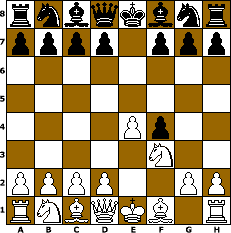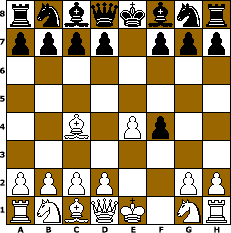The King“s Gambit is a chess opening that begins (in algebraic notation)
1. e4 e5 2. f4
This opening was the most popular opening in the 19th century. White offers a pawn in exchange for rapid development. It is now rarely seen at the master level, it being generally thought that Black can obtain a reasonable position by giving back the gambited pawn at the right moment.
Variations
Black must decide whether or not to accept the gambit. Since White cannot easily regain the pawn if Black accepts, the King“s Gambit Accepted is the most common. It also provides black a choice of different defenses.
King“s Gambit Declined
A common way to decline the gambit is with 2. ..Bc5, the "classical" KGD (King“s Gambit Declined). The bishop prevents white from castling and is such a nuisance that white often expends two tempi to get rid of it, moving the queen“s knight to c3 and then to a4 only to exchange it on c5, whereupon he may castle without worry. The opening is generally considered to give white too much space in the center after continuations like 1.e4 e5 2.f4 Bc5 3.Nf3 d6 4.c3 Nf6 5.d4 or 5.fxe5, and so is no longer played frequently despite being very popular in the 19th century.
Other declined options, such as 2. ..Nc6, 2. ..d6, or 2. ..f6!? are weak.
Black can go further and play 2...d5, the aggressive Falkbeer Countergambit, where Black disdains the pawn and instead makes an all-out attempt to take advantage of white“s kingside weakness. It is generally considered to slightly favor White, however.

The King“s Knight Gambit
As stated above, Black best accepts with 2... exf4. White then has two main continuations: 3. Nf3, the King“s Knight Gambit, ECO code C34, is the most common as it develops the knight and blocks 3... Qh4+, and 3.Bc4, the Bishop“s Gambit, where White“s development will rapidly increase after 3... Qh4+!? 4. Kf1 followed by 5. Nf3, driving the queen away and gaining a tempo, however, most modern players will not bring out the queen. Other third moves such as 3. Qf3 (with the idea of ..Qh4+ 4.g3..fxg3 5.hxg3..Qf6 6.o-o), and even 3.Qe2 and 3.Ne2, are playable but rare.
The Classical Variation usually leads to either the relatively positional Kieseritsky Gambit 1.e4 e5 2.f4 exf4 3.Nf3 g5 4.h4 g4 forced 5.Ne5, which has many continuations, or the extremely sharp Muzio Gambit 4.Bc4 g4 5.o-o! gxf3 6.Qxf3, where white has gambitted a whole piece but has three pieces all bearing down on black“s isolated king“s bishop“s pawn, his weakest square. Such wild play is rare in modern chess. If Black is unfamiliar with the Muzio it may be wiser for him to play 4. ..Bg7 instead.
After 3.Nf3 g5 4.h4 g4 5.Ng5 the Allgaier Gambit arises, sacrificing the knight, a way to avoid the Kieseritzky Gambit.
The Berlin Defense 3. ..h6 has the idea of creating a pawn chain on h6, g5, f4 to defend is f4 pawn while avoiding the Kieseritsky Gambit.
The Cunningham Defense 3. ..Be7 is black“s most aggressive option; it can permanently prevent white from castling after 4.Bc4 Bh4+ 5.Kf1 (else the wild Bertin Gambit, or Three Pawns“ Gambit 5.g3 fxg3 6.o-o gxh2+ 7.Kh1.) However, nowadays it is more common for black to simply play 4. ..Nf6 5.e5 Ng4, the Modern Cunningham.

The Bishop“s Gambit
The Abbazia Defense has much the same idea as the Falkbeer Counter-Gambit, and can in fact be transposed in; black“s forward pawn is less well placed on f4 than on e4, but material is even.
The extremely popular Fischer Defense (1.e4 e5 2.f4 exf4 3.Nf3 d6 planning h6 and g5 but only rarely Bg4, a natural-looking but often weak move that beginners play too early) is complicated and subtle. After Bobby Fischer lost a 1959 game at Mar del Plata to Boris Spassky, in which the Kieseritsky Gambit (above) was played, he left in tears and promptly went to work at devising a new King“s Gambit defense. In a 1962 article titled "A Bust to the King“s Gambit" he put forth this idea and claimed that it refuted the King“s Gambit, which was clearly not the case. The article concluded with the famously arrogant line "Of course white can always play differently in which case he merely loses differently." Nonetheless, the article was possibly the most influential ever written about an opening, and ever since the King“s Gambit has been rare in Grandmaster play, though a few players such as Joseph Gallagher still use it.
|
